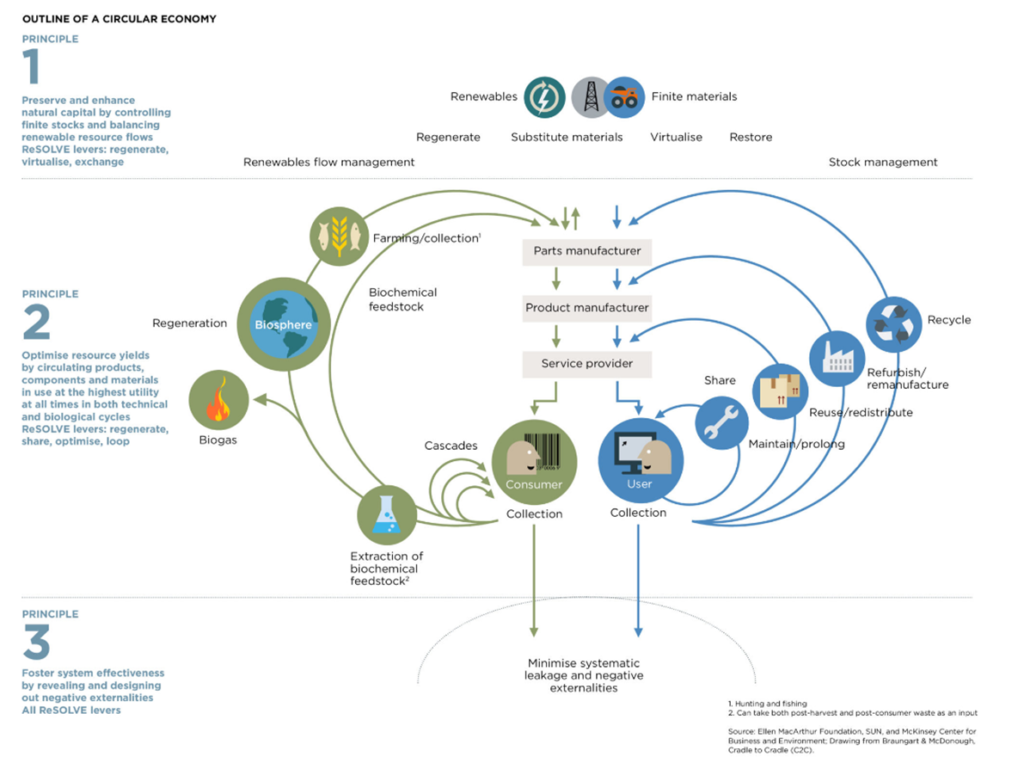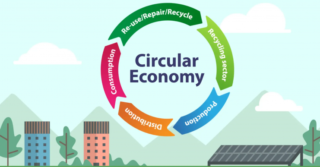The business case for the Circular Economy
In the first article of the series we defined Circular Economy as an economic model that attempts to decouple “economic activity from the consumption of finite resources.” We also discussed the history and background of the movements that led to its rise in popularity. This second article now looks at how that popularity has fostered C-suite and board level conversations in many of today’s top corporates, and the potential social and economic impacts of the opportunity that shape those conversations and subsequent circular business strategies.
In many instances, the circular economy is tied to disruptive innovation. According to Ellen MacArthur, “ultimately, the circular economy is about organizations ‘turning things on their head’ and completely re‑thinking how resources are managed in order to enhance financial, environmental and social benefits, both in the short and long term[1].”
The Journal of Cleaner Production[2] further describes how the circular economy disrupts by using market and other incentives to “motivate and support sustainable business innovation to close, slow, and narrow resource loops (Bocken et al., 2016).
(Source:https://www.ellenmacarthurfoundation.org/circular-economy/infographic)
In this way, the transition to the circular economy implies a whole-system change…from product design and industrial manufacture to the conception of entirely new business models, including the way value is created, captured, and delivered to customers (Osterwalder and Pigneur, 2010).
In many companies value creation begins with waste reduction. For the past 20 years, the Global Footprint Network has assigned a day on the calendar for when “humanity will have used nature’s resource budget for the entire year”[3]. July 29, 2019 is the most recently recorded World Overshoot Day, having moved up two days from August 1st in 2018. Assigning this date means that in 2019 we are using nature 175 times faster than our planet’s ecosystems can regenerate.
Over-consumption is a social and environmental challenge. Because this challenge is intrinsically linked to wasted resources, it creates an economic opportunity. A 2015 Imperial College London report, commissioned by our member Veolia, found that the circular economy can contribute 5,000 jobs and €1.65 billion in GDP (.7%) to Ireland alone, primarily in plastics, WEEE and paper reclamation[4]. According to McKinsey[5], the circular economy represents a €1.8 trillion economic opportunity across the EU and according to the World Economic Forum[6], a €4.5 trillion economic opportunity worldwide. Our member company Accenture believes that number could be as high as $25 trillion by 2050[7].
Traditionally, waste has been the most frequently represented aspect of the circular economy in policy and business strategies. Governmental policies like “producer pays” and the implementation of “pay for use” waste and water charges have incentivised companies to initiate cost savings campaigns aligned with reducing waste and related charges.
More recently though companies are incentivised toward more efficient use of materials and toward purchasing secondary raw materials by volatile raw material prices. Peter Lacy, Director of Accenture Strategy and co-author of Waste to Wealth characterises the linear business model as having “begun to choke economic growth through unpredictable raw material prices and the increased cost of depending on less stable supplies of constrained resources.”[8]
Seeking cost efficiency and material price stability through waste reduction, increased efficiency, and the introduction of secondary raw materials into production flows has resulted in new business models, innovative sourcing strategies and new levels of transparency in global supply chains. These benefits are realised through using a Systems Design approach to build a more holistic strategy right across the business value chain.5
Royal Philips is one example of a company that has begun using systems design to gradually make its business model more circular. Philips CEO, Frans van Houten stated that in 2012 they began to “embed circular-economy thinking in [their] strategic vision and mission” believing that it could result in cost savings, drive “breakthrough thinking and generate superior margins”[9]. What has resulted since that initial embedding are such initiatives as Philips Lighting “Pay Per Lux” service and the development of Philips Healthcare $200m medical device leasing and refurbishment business. Looking ahead, Philips has committed generating 15% of its revenues through circular economy-driven propositions by 2020[10]. This business strategy has contributed to the strong and sustainable financial results Phillips continues to maintain. “PHIA’s profit growth over the previous five years has been positive, with an average annual rate of 14%, beating the industry growth rate of 13%. This consistent market out-performance illustrates a robust track record of delivering strong returns over a number of years”[11].
This article provides an overall view of the business case driving many companies toward a more circular business model. That business case is supported at the EU level by the Circular Economy Action Plan that was established in 2015 by the European Commission to “accelerate Europe’s transition towards a circular economy, boost global competitiveness, promote sustainable economic growth and generate new jobs”12. The plan established measures intended to “close the product lifecycle loop” and identified five sectors (plastics, food waste, critical raw materials, construction and demolition, biomass and bio-based materials) to prioritise[12]. In 2019, the first progress report was published. It was found that while the plan had accelerated transition toward the circular economy, there was significantly more work yet to be done[13].
The next article in the series will discuss the work that is yet to be done, and also the tariff and non-tariff barriers that incentivise and reinforce a linear economy.
BITCI can support you. If you want to find out more, please contact our Circular Economy expert Maureen O’Donnell
Additional links:
[1] BS 8001. Framework for implementing the principles of the circular economy in organizations – Guide
[2] https://www.sciencedirect.com/science/article/pii/S0959652617331396
[3] https://www.prnewswire.com/news-releases/earth-overshoot-day-2019-is-july-29-earliest-date-ever-300889072.html
[4] Veolia, 2015. The Circular Revolution in Ireland
[5] McKinsey
[6] World Economic Forum, n.d. Platform for Accelerating the Circular Economy.
[7] https://newsroom.accenture.com/news/the-circular-economy-could-unlock-4-5-trillion-of-economic-growth-finds-new-book-by-accenture.htm
[8] https://newsroom.accenture.com/news/the-circular-economy-could-unlock-4-5-trillion-of-economic-growth-finds-new-book-by-accenture.htm
[9] https://www.mckinsey.com/business-functions/sustainability/our-insights/toward-a-circular-economy-philips-ceo-frans-van-houten
[10] https://www.philips.com/a-w/about/news/archive/standard/news/press/2018/20180220-philips-increases-green-revenues-to-eur-10_7-billion-60-percent-of-total-sales-in-2017.html
[11] https://simplywall.st/stocks/nl/healthcare/ams-phia/koninklijke-philips-shares/news/consider-these-factors-then-buy-koninklijke-philips-n-v-amsphia/
[12] https://ec.europa.eu/commission/publications/report-implementation-circular-economy-action-plan-1_en
[13] https://ec.europa.eu/commission/sites/beta-political/files/report_implementation_circular_economy_action_plan.pdf
Tags:








